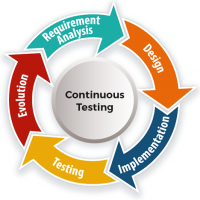With the arrival of continuous integration/continuous delivery (CI/CD), the notion of continuous testing is taking center stage. Knowing that comprehensive tests are running smoothly can be of benefit for the CI/CD pipeline. Using the repetitive character of CI/CD for testing can be a way to address issues.
Many people confuse continuous testing with test automation. That makes sense, because you cannot do continuous testing without automated tests. But it is much more. Continuous testing has a higher-level maturity that could require a totally different way of working—but it also gives a faster path to production.
Continuous testing means testing before, during, and after each software change is made. Testers have long advocated for this, but DevOps has made it more popular by pushing for rapid feedback and shifting testing left in the lifecycle. Here are three practices your company should embrace to enable continuous testing.
Continuous testing started when DevOps got hot as organizations began trying to figure out how to make everything in the software delivery process more continuous and testers felt they were being left out of the DevOps movement. If you want to get started with continuous testing, here are three things you should know.
Continuous testing minimizes risk and ensures DevOps has the tools to deliver quality, modern code that is ready for the future. To fulfill this, you have to first understand the three types of personas in testing. Then, you'll know how to work with them to progress along the path toward achieving continuous testing.
The concept behind continuous testing is far from new, but what’s different now is that software development practices have evolved to a point where developers are embracing testing as part of their responsibilities. Testing is slowly moving from being an “event” to an activity throughout the development lifecycle.
Security is often the black sheep of testing—an afterthought that gets only a scan before release. We have to make security a first-class testing citizen with full-lifecycle support. For the best impact, introduce security testing into the early phases of the continuous testing pipeline. Here are some tools to help.
Scaling agile and DevOps across a large enterprise is much more difficult than practicing it in smaller groups. Frameworks can help, but focus tends to be placed on development, so testing teams struggle to figure out how to best support faster development cycles. The ACT Framework puts the focus on continuous testing.
Continuous testing entails executing automated tests to obtain rapid feedback on business risks. Where does that leave exploratory testing? Obviously, it doesn’t make sense to repeat the same exploratory tests across and beyond a sprint, but exploratory testing can be a continuous part of each software delivery cycle.
Continuous testing can help you achieve the optimal balance between speed and risk and deliver high-quality products faster. But what exactly does continuous testing entail? Is it just shifting testing left in a DevOps environment? And where does automation fit in? Here's a breakdown of all these testing concepts.
Software teams using continuous delivery focus on building software in small pieces so that new code can be pushed to production multiple times a day instead of on a sprint cadence. There is also an explicit focus on code quality before production and monitoring afterward. Is this putting testing in danger?
In any project, for a quality product or application rollout, regression testing plays a key role. The challenge comes with regularly examining your regression suite and making sure it is running optimally. The optimization process should be implemented with every major release to ensure efficient testing.
With the DevOps movement and push for continuous delivery, the way we have done test automation in the past must evolve. In continuous testing, tests are run as part the build pipeline so that every check-in and deployment is validated. Learn more to ensure your team can achieve continuous testing.
"Continuous" gets mentioned a lot in agile and DevOps, but one area that often doesn’t get enough attention is how to continuously build, test, and deliver secure applications. Just like for quality, you can’t test security in, so you need to have a plan for how to build it in. Here are some tips on how to do that.
Continuous backlog grooming means systematically refining your user stories: breaking up larger stories, obtaining detailed requirements, writing the requirements in terms of acceptance criteria and acceptance tests, and sharing and refining these details with the team. Acceptance test-driven development can help.




























